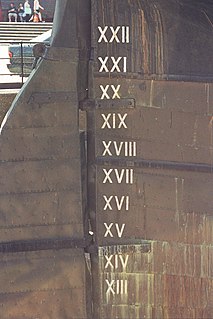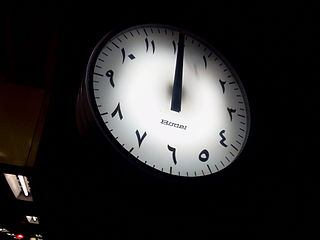Arabic numerals are the ten numerical digits: 0, 1, 2, 3, 4, 5, 6, 7, 8 and 9. These are by far the most commonly used symbols to write decimal numbers. They are also used for writing numbers in other bases such as octal, and for writing identifiers such as license plates.
Chinese numerals are words and characters used to denote numbers in Chinese.
The decimal numeral system is the standard system for denoting integer and non-integer numbers. It is the extension to non-integer numbers of the Hindu–Arabic numeral system. The way of denoting numbers in the decimal system is often referred to as decimal notation.

A numeral system is a writing system for expressing numbers; that is, a mathematical notation for representing numbers of a given set, using digits or other symbols in a consistent manner.
In linguistics, a numeral in the broadest sense is a word or phrase that describes a numerical quantity. Some theories of grammar use the word "numeral" to refer to cardinal numbers that act as a determiner that specify the quantity of a noun, for example the "two" in "two hats". Some theories of grammar do not include determiners as a part of speech and consider "two" in this example to be an adjective. Some theories consider "numeral" to be a synonym for "number" and assign all numbers to a part of speech called "numerals" Numerals in the broad sense can also be analyzed as a noun, as a pronoun, or for a small number of words as an adverb.

Roman numerals are a numeral system that originated in ancient Rome and remained the usual way of writing numbers throughout Europe well into the Late Middle Ages. Numbers in this system are represented by combinations of letters from the Latin alphabet. Modern style uses seven symbols, each with a fixed integer value:
A senary numeral system has six as its base. It has been adopted independently by a small number of cultures. Like decimal, it is a semiprime, though it is unique as the product of the only two consecutive numbers that are both prime. As six is a superior highly composite number, many of the arguments made in favor of the duodecimal system also apply to base-6. In turn, the senary logic refers to an extension of Jan Łukasiewicz's and Stephen Cole Kleene's ternary logic systems adjusted to explain the logic of statistical tests and missing data patterns in sciences using empirical methods.

San Dimas is a city in the San Gabriel Valley of Los Angeles County, California, United States. As of the 2010 census, the city had a total population of 33,371. The city historically took its name from San Dimas Canyon in the San Gabriel Mountains above the northern section of present-day San Dimas.
A binary number is a number expressed in the base-2 numeral system or binary numeral system, a method of mathematical expression which uses only two symbols: typically "0" (zero) and "1" (one).

Positional notation usually denotes the extension to any base of the Hindu–Arabic numeral system. More generally, a positional system is a numeral system in which the contribution of a digit to the value of a number is the value of the digit multiplied by a factor determined by the position of the digit. In early numeral systems, such as Roman numerals, a digit has only one value: I means one, X means ten and C a hundred. In modern positional systems, such as the decimal system, the position of the digit means that its value must be multiplied by some value: in 555, the three identical symbols represent five hundreds, five tens, and five units, respectively, due to their different positions in the digit string.
Quinary is a numeral system with five as the base. A possible origination of a quinary system is that there are five digits on either hand.
Etruscan numerals are the words and phrases for numbers of the Etruscan language, and the digits used to write them.

The Hindu–Arabic numeral system or Indo-Arabic numeral system is a positional decimal numeral system, and is the most common system for the symbolic representation of numbers in the world.

The Eastern Arabic numerals, also called Arabic–Hindu numerals or Arabic–Indic numerals, are the symbols used to represent numerical digits in conjunction with the Arabic alphabet in the countries of the Mashriq, the Arabian Peninsula, and its variant in other countries that use the Persian numerals on the Iranian plateau and in Asia.
Seediq, also known as Sediq, Taroko, is an Atayalic language spoken in the mountains of Northern Taiwan by the Seediq and Taroko people.
In linguistics, ordinal numerals or ordinal number words are words representing position or rank in a sequential order; the order may be of size, importance, chronology, and so on. They differ from cardinal numerals, which represent quantity and other types of numerals.
Ngkolmpu Kanum, or Ngkontar, is part of a dialect chain in the Yam family spoken by the Kanum people of New Guinea. The Ngkâlmpw (Ngkontar) and moribund Bädi varieties have limited mutual intelligibility may be considered distinct languages.
Kéo or Nagé-Kéo is a Malayo-Polynesian dialect cluster spoken by the Kéo and Nage people that reside in an area southeast of the Ebu Lobo volcano in the south-central part of Nusa Tenggara Timur Province on the island of Flores, eastern Indonesia.
Tungag, or Lavongai, is an Austronesian language of New Ireland Province, Papua New Guinea.